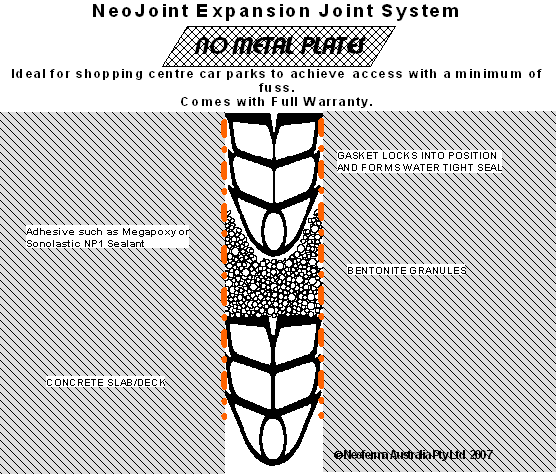Neoferma Neojoint
Neojoint Applications

Neojoint Uses
Expansion Joint Sealing System
From a designers perspective, expansion joints are a necessary evil. Whilst their primary function is to enable the structure to expand and contract consequent to geophysical, hydraulic and atmospheric forces, an unwanted side effect is that the integrity of the waterproofing of the structure is often compromised.
Such failings can have serious and, ultimately, extremely costly consequences.
By way of example:
- Building facade joints may lose their protective properties in the event that wind driven rain transgresses the joint seals
- High rise buildings with basements below the water table may experience chronic and potentially damaging flooding
- Failed joint seals in hardstands and loading docks at chemical plants and service stations forecourts will allow seepage of toxic materials into the ground water
- Swimming pools and reservoirs can lose vast quantities of water through undetected and undetectable joint leaks
- Roadways and bridges can become susceptible to surface damage as sealants deteriorate exposing joint walls to cumulative impact and pressure damage
Traditionally, most joints are sealed with liquid applied silicon sealants. There are inherent limitations with these systems. In the first place, if care is not taken during application, the sealant may not adhere to both walls of the joint.
Secondly, over time, the elasticity of the sealant can reduce and its plasticity increase to the point of it becoming ineffective. This process can be accelerated under some conditions. In both circumstances the sealant needs to be replaced. Although the cost of the sealant may not necessarily be that great, the cost of preparation, disruption and application can be very expensive; and it will need to be repeated over time.
NeoJoint (patent pending) is a cost effective alternative option to affect a permanent watertight seal to expansion joints of any nature, both positive and negative. The system is simple in its application yet high in its waterproofing integrity. Neojoint also has excellent sound insulating properties.
NeoJoint comprises a twofold system with each of the elements enhancing the inherent waterproofing properties of the other. These two elements include sodium bentonite and Neoferma, an EPDM rubber compression seal. Sodium bentonite is a naturally occurring mineral which is inert but which has the capacity to expand up to 15 times its dehydrated state. EPDM is a highly durable synthetic rubber that can withstand extremes of temperature and tolerate high UV exposure. In application, sodium bentonite, in one of three forms (powder, paste or extrusion), is placed at the base of the expansion joint.
The Neoferma is compressed and inserted into the joint over the sodium bentonite and finished flush with the surface. In the event that water seeps into the joint either from sub-structure sources or from above, by bypassing the Neoferma compression seal, it will come into contact with the sodium bentonite. As the sodium bentonite hydrates it expands and exerts considerable pressure on the Neoferma compression seal. This pressure forces the lateral fins on the Neoferma to increase and strengthen the surface contact with the walls of the joint effectively tightening the seal. Once hydrated, to the extent possible under the constraint of the Neoferma, the sodium bentonite itself becomes an impervious barrier. So, each of the two elements have maximised their respective waterproofing properties to realise a joint seal that is secure and permanent.
The finished joint needs no protection and can be immediately exposed to vehicular and pedestrian traffic.
Visually, the joint is neat and tidy and aesthetically pleasing.
Further, Neoferma can be produced in virtually any colour to ensure it is sympathetic with the colour scheme of the structure to which it is fitted.
